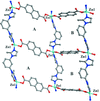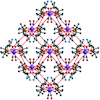issue contents
September 2020 issue

Cover illustration: A set of rhodium complexes involving functionalized allyl- and cyanoalkylphosphines shows an inverse dependence between the Rh-P distance and the coupling constant JP-Rh and the IR ![[nu]](/logos/entities/nu_rmgif.gif) (C
(C![[triple bond]](/logos/entities/z-tbnd_rmgif.gif) O) bands, which account for the poor
O) bands, which account for the poor ![[pi]](/logos/entities/pi_rmgif.gif) -acceptor Rh-P electronic bonding feature of these ligands. See Atencio, Chacón, Mendoza, González, Bruno-Colmenare, Rosales, Alexander & Ocando-Mavárez [Acta Cryst. (2020), C76, 932-946].
-acceptor Rh-P electronic bonding feature of these ligands. See Atencio, Chacón, Mendoza, González, Bruno-Colmenare, Rosales, Alexander & Ocando-Mavárez [Acta Cryst. (2020), C76, 932-946].
research papers














 access
access





 access
access





 access
access



 journal menu
journal menu































